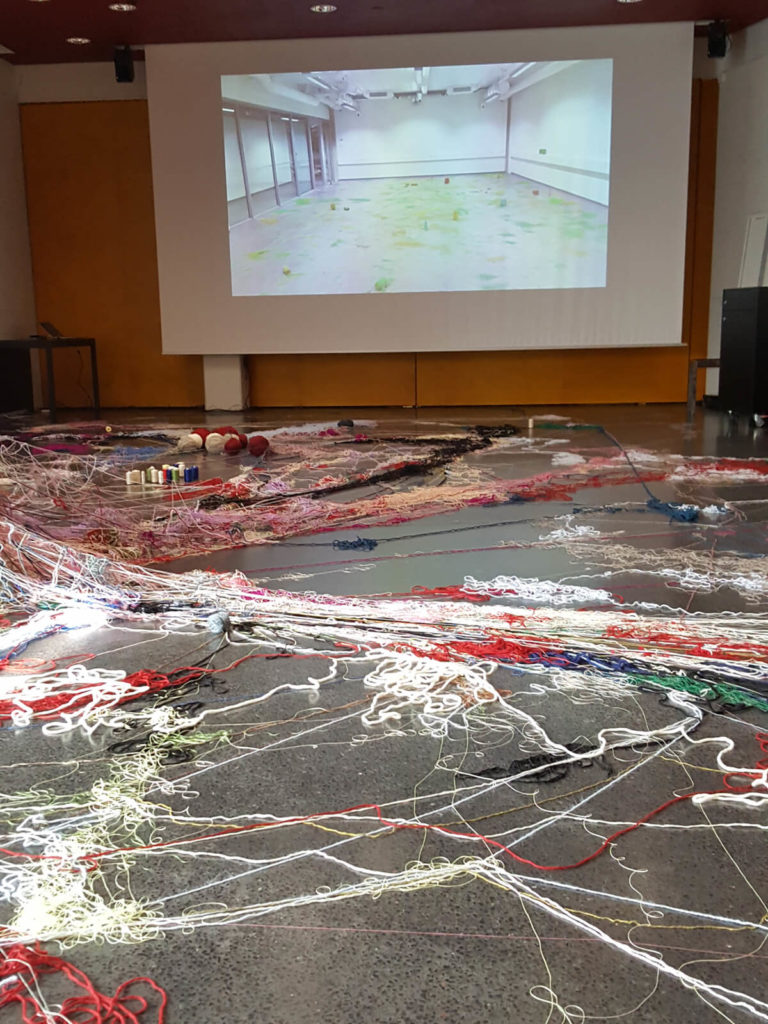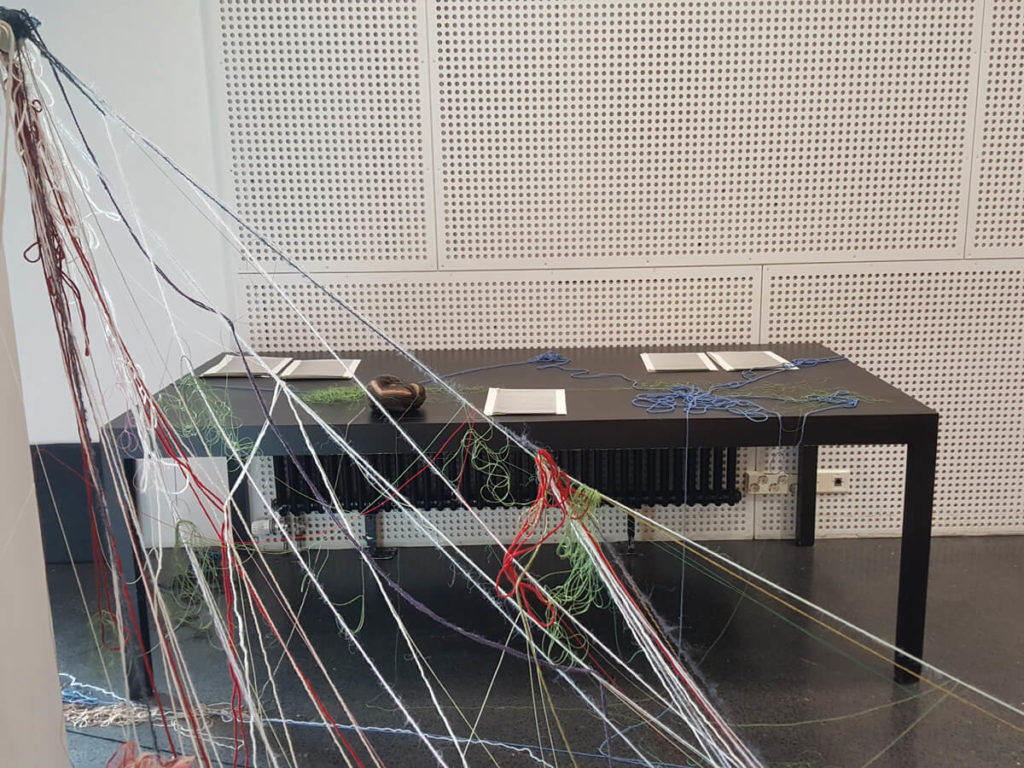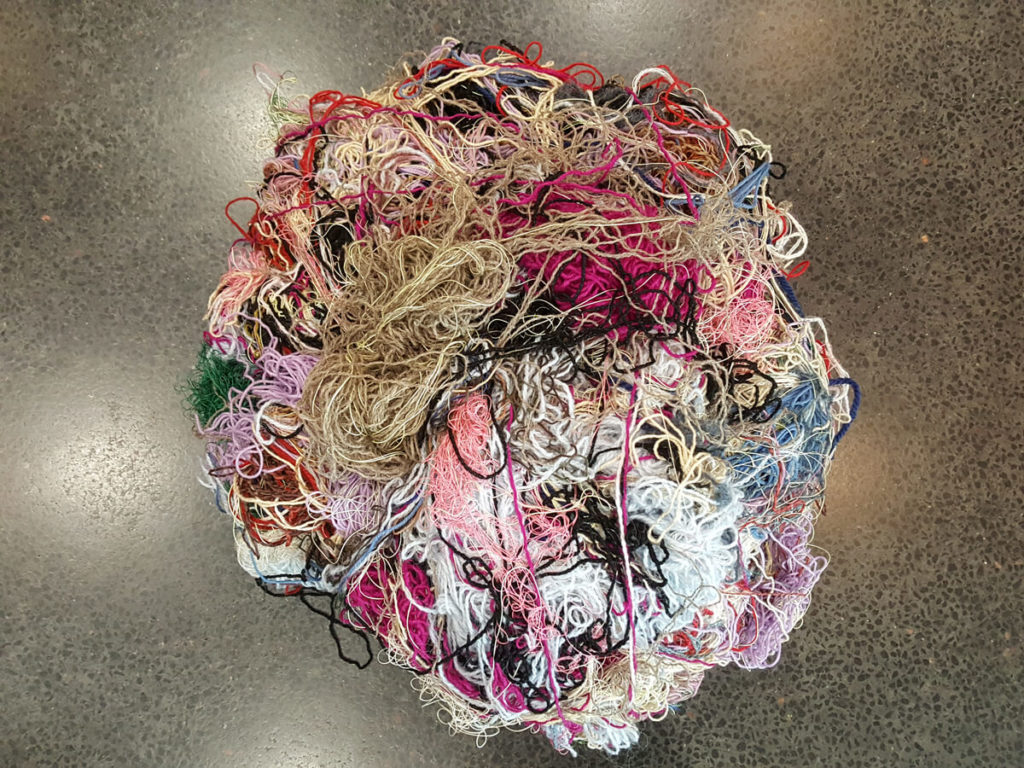Abstract
“Keep on Threading or: TITLE” is a study and a site for cones of yarn and a human performer. Laying out yarn for six hours the performance creates situations embracing the labor of the hands (and the mind), the materiality of breath and temporality as net (boredom, excess, ex-centrism). “Keep on Threading or: TITLE” is considered a type of study without learning (Harney/Moten) where people are invited to join the rolling off yarn from the cones or simply sit n’rest n’see / n’have a book or tea / and hang in there for a while. “Keep on Threading or: TITLE” is a continuation of the collaboration of Norwegian visual artist Tina Jonsbu and Jana Unmüßig who met at the summer academy for artistic research in Tromso, Norway, 2015. Since then three performative experiments with different yarn have been presented: THREADS (2015, Tromso), THOUGHTS ON THREADS (2017, Berlin), TWO BODIES IN SPACE (2019, Rovaniemi). Performative durational experiment for one performer with yarn.
Keep on Threading or: a TITLE is part of an ongoing artistic dialogue between visual artist Tina Jonsbu and myself, Jana Unmüßig, artist-researcher with a background in choreography and contemporary dance. The following text thinks with the performative experiment Keep on Threading or: a TITLE that was performed at CARPA6 in August 2019.
The Space
On one side of the space, there is a row of tables onto which the public finds a written introduction to the durational performance Keep on Threading or: a TITLE.
On one side of the room, there is another table with experts from three different texts[43] that can be read by the public during the performance.
On another side of the space, there is a video projection that shows excerpts of the documentation of previous performances of the same proposal.
On yet an another side of the space, there is a table with tea.
All the rest of the space is covered by piles of wool and threads.
The public can come, go and stay as they wish. They are invited to join me undoing all the balls of yarn.
Collaborating as a How are you doing?
Writing about Keep on Threading or: a TITLE entails writing about the encounter between Tina and I. Tina and I collaborate on equal terms. That is: we discuss until we find a decision that we are both satisfied with. That might also entail at times that we decide that one does the proposal without the other: at CARPA6 I was performing alone, because Tina had schedule conflicts.
Before I got to know Tina, I had never co-authored or co-signed a work process. I had collaborated with dancers but it was always my name in bold letters when we went public with the work. And there was always the clear hierarchical structure between choreographer-fundraiser-rehearsal-facilitator and the dancers/performers performing the work, my work. When meeting Tina, I had left my choreographic practice, developing and signing group choreographies, and I was interested in shifting modes of doing work. I wanted to work differently. Doing work differently was a way to imagine myself out of the circuits of exchange. However, collaborations and more openly framed processes, such as our project, are still part of “projective temporalities” (Kunst 2012) and are ultimately part of the exchange circuit, by e.g. presenting a piece at CARPA6. But, there is an ethical imperative of collaborating as Tina and I do. As I have argued elsewhere[44], our collaboration entails the question ‘How are you doing’?. We ask this question as two artists that are interested in each other’s work and working and how it will develop further.
Collaborating: Common Paths with Twists
When Tina and I met in Tromso, Norway, at the Summer Academy for Artistic Research in 2015, we had a shared interest in some sort of reluctance to performance and performing. Perhaps, we identified performing as being part of the major. We worked with this reluctance to performance, in our individual practices, by addressing the doing of almost nothing or at least: Rather doing very little than a lot. Looking for the zero-ground brought our attentions closer to minimalism without ever feeling totally at ease with describing, labeling our individual works as minimal.
Tina and I were quite aware of gender, (we had from the start lengthy conversations on motherhood and kids, relationships with our partners and other life matters of women-artists), and women-artists doing ‘difficult work’. We never discussed in detail what we meant by ‘difficult work’ but, probably what we meant was work that was reluctant to representation and proposed itself in the very first place through an immense openness: An openness that was populated by everyday gestures and doings that challenge interpretations because of the miniature quality of their appearance.
We also shared a certain struggle with theory and its place in our works. We tackle this struggle quite differently in our individual practices. I have rather the tendency to back up everything through theory when it comes to research. Probably out of a certain kind of anxiety. Tina is more concerned with contextualizing her work through the actual artistic doing. In our collaboration, we never read theories or even exchanged about possible theoretical frameworks. We are both artists that are guided by a certain kind of intuition, rigorous intuition.
We both consider ourselves as doing slow work, and working slowly. Tina prepares her visual art carefully before she starts actually doing it. In our collaboration that would show for example like this: Tina created lists of the different lengths of a yarn. She would measure the time it takes to unroll it, and rewind it. She would do this with each yarn we used. I was less concerned with this, but rather with how we would deal with the material in relation to the body. We kept saying ‘we just do it’. Tina has been able to really just do it throughout the project, whereas I still get easily caught up in images: images of the inner landscape of my body (undoing the yarn, I check in with the relation between my hip, femur, jaw) and with images of appearance (how does my body image come across for the public).
The Material
Yarn
I don’t remember precisely how we came up with the material of threads and wool. I remember that Tina suggested the material, wool and threads, due to her embroidery practice. Tina remembers that I suggested the material. In any case, we started off with wool, extended also to threads and remained with both materials. I had been curious about weaving since having used, some years before, writings of the music composer Morton Feldmann in order to address a kind of temporality I experienced when composing a new work, when choreographing. Tina and I were aware of how gendered the material is. We struggled with that but ended up allowing us to use it without being too concerned about how it has been used. We are aware of the lineage of female artists having worked with threads or wool (Rosemarie Trockel, Chiharu Shiota, Karla Black, Hedwig Vinge etc.). We have not studied any of these artists’ works more closely and so it remains difficult to say how our contribution connects or differs from their proposals. This is something to be done in the future. In Keep on Threading or: a TITLE and also in all the other performances we did so far[45], we have laid the wool and threads out on the floor by simply undoing the ball of the wool or thread. The action was simple. We wanted to cover the floor as much as possible; creating some sort of carpet. But we also had the question of how to end the performances. Ideally, it would go on for almost ever. I had trouble with understanding what to do with the material once the performance is over. I was concerned about the waste we produced through this performance. In my earlier work, where choreographies happened on bare stages without music, my body or other bodies left fairly little material remains after a performance was over. For the performance at CARPA6 we were lucky, because I was able to borrow the yarn from an extended family member of mine and I got told to give it to that person when I was done with the performance. So, there was no waste. But the yarn keeps being in use, is up-cycled.
Text
For some while now, I have had a growing interest in making theoretical references that I connect explicitly to this project. Since I accommodated the proposal for CARPA6 more on my own than in the previous ones, I laid out some texts that I find interesting to read with the performance. Such as Kirsten Maar’s Exhibiting Choreography. Kirsten Maar asks: “But what exactly move the artists to extend their former institutional background? For sure, these are artistic decisions, but they are not free from economic considerations or “selling” their work in the context of another art market, and from the side of the museum, there is the wish to attract a larger public, which would come to see each “event” of the fugitive art form.” (Maar 2014, 97). Performing in the museum as choreographer I am complicit with “performance capitalism” (Manchev 2016). But, since there is, at least for now, no way out of constant commodification of some kind, it is important to keep practicing performing differently, asking how where when do I perform. With this in mind, I want to draw, one more time, attention Kirsten Maar’s text. In it she points out how dance is historically and in everyday life something that is not merely watched but done, performed, together. In traditional theater set ups this aspect of dance is most often not considered. In the context of e.g. a museum there are more possibilities to arrange and assign dance differently. (Maar 2014, 106). Keep on Threading or: a TITLE asks the public to collaborate, to join in laying out the yarn, in creating a carpet. Keep on Threading or: a TITLE can be considered a score for wool, thread and people. A score is “characterized by its inherent potentiality. It describes an assignment within which movement can unfold.” (Maar 2014, 107) It can. It does not necessarily need to. In Keep on Threading or: a TITLE movement is an option and not an imperative. Keep on Threading or: a TITLE assigns movement to people and yarn. It applies the concept of score as a choreographic procedure (Maar 2014, 107) and extends in that sense choreography as an art form that unbound from dance.




Notes
43 These texts were Queer Phenomenlogy (2006) by Sara Ahmed / Assign and Arrange (2014) edited by Maren Butte, Kirsten Maar, Fiona McGovern, Marie-France Rafael, Jörn Schafaff / Critique and Postcritique (2017) edited by Elisabeth S. Anker and Rita Felski.
44 See: Proceeding of Floating Peripheries Conference 2019, University of Lapland. Forthcoming in RUUKU issue PERIPHERIES, end of 2019.
45 performance without title at the Summer School for Artistic Research Tromso, Norway (2015), Thoughts on Threads (2017), Two Bodies with Yarn (2019).
References
Kunst, Bojana. 2012. “Project Horizon: On the Temporality in Making” In Manifesta Journal (MJ#16), https://www.manifestajournal.org/issues/regret-and-other-back-pages/project-horizon-temporality-making (last retrieved 16.11.2019).
Maar, Kirsten. 2014. “Exhibiting Choreography” In Assign and Arrange, Eds. Maren Butte, Kirsten Maar, Fiona McGovern, Marie-France Rafael, Jörn Schafaff, 93–112. Sternberg Press: Berlin.
Manchev, Boyan. 2016. “Nothing in Common. Collaborations, relations, processes, and the actuality of artistic labour” TkH, Journal for Performing Arts Theory, No23: 49–52.
Jana Unmüßig
Jana Unmüßig, D.A. (dance), has presented her choreographed group works among others at Kampnagel Hamburg, Hebbel am Ufer Berlin, Zodiak – Center for New Dance Helsinki, Impulstanz Vienna. Since 2015 she focuses mainly on the research side of her artistic doing. She holds a position as post-doctoral researcher at the Center for Artistic Research (CfAR) at Uniarts Helsinki. Jana acts as visiting researcher at the Performing Arts Research Center of Teak / Uniarts Helsinki. www.jana-unmussig.com.